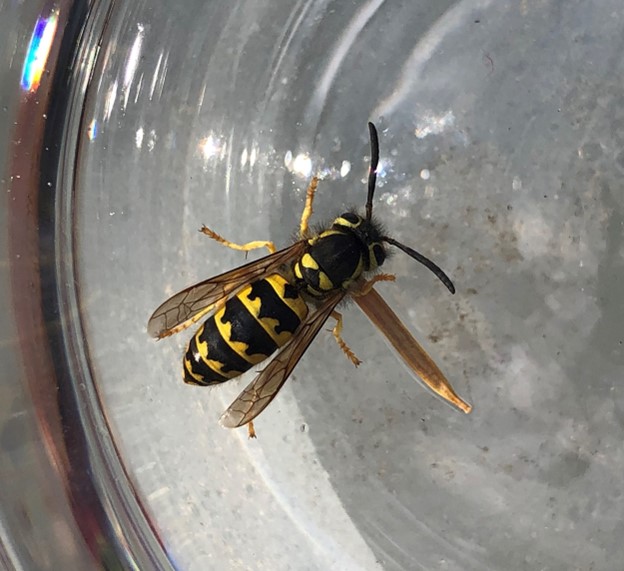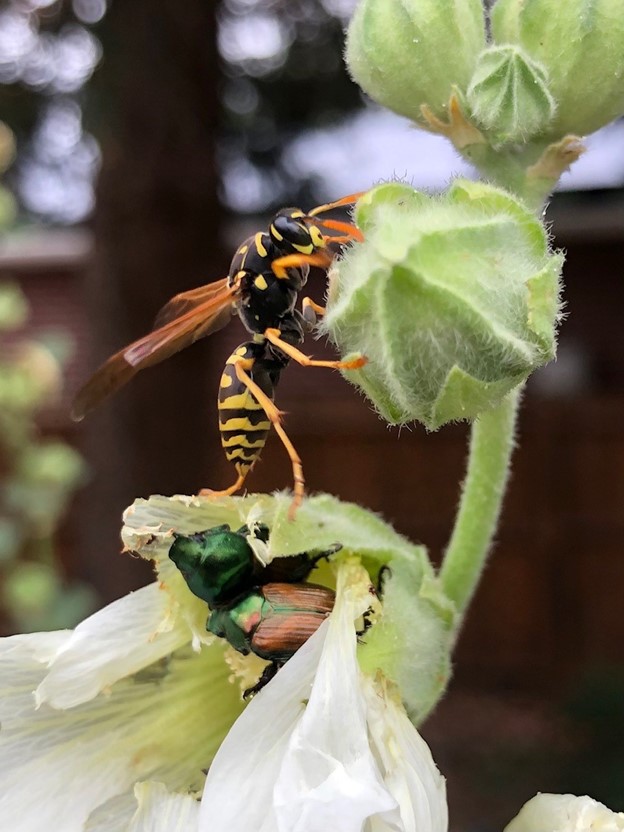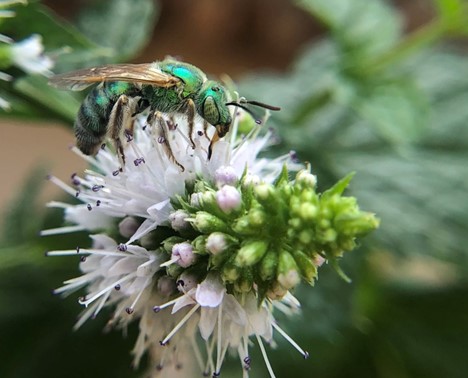From the Hort Desk
- 2023-09-04
- By mkirk
- Posted in Horticulture, The Garden Buzz
By Lisa Mason, CSU Extension Horticulture Agent
Taking the Sting out of Insect Encounters
Summer is here. Time to play outside and enjoy the sunshine! Outdoor activities often involve observations and interactions with insects. While most insects are harmless, we do have some species that can sting.
Both bees and wasps can sting. A stinger is a modified ovipositor (the egg-laying mechanism in insects), so only females can sting. The purpose of a stinger is defense, and in some species, predation on other insects. Generally, insects will only sting if they are provoked or if they feel their colony/nest is threatened. Wasps can sting more than once, while honey bees can only sting once.

Western Yellowjackets
Western yellowjackets are responsible for 90%+ of all stings in Colorado. When someone says, “I was stung by a bee,” they were likely stung by a yellowjacket. The western yellowjacket is much more likely to sting because they are scavengers. Their role in the ecosystem is to be part of the “clean-up crew” by feeding on carrion (dead animals). They also happen to be attracted to human foods, and tend to fly around picnics, BBQs, trash cans, etc. They tend to be more aggressive in the late summer/fall when temperatures cool down and food is harder to find.
Control options:
- Hang yellow tube traps that use the pheromone heptyl butyrate in March or April to attract queens emerging from hibernation. These traps will only attract yellowjackets and not beneficial insects like bees. Do NOT use traps that rely on sugar and UV light to attract insects.
- Yellowjackets build their nests underground. Nests can be hard to find unless they build them close to human activity. If a nest is too close for comfort, consider hiring a professional pest control company. Yellowjackets will protect their nest if they feel threatened, creating a potentially dangerous situation. The nests are well-protected underground, so wasp sprays are not effective. Insecticidal dusts may also have limited effectiveness.

European Paper Wasps
European paper wasps are an invasive species that has dramatically altered our garden ecosystems. They primarily feed on caterpillars. Most social wasps, including the European paper wasp, are generally not aggressive unless their nest is disturbed. Stings from the European paper wasp usually happen when humans are unaware a nest is present in a shed, or other dark location. They tend to build nests close to human activity on buildings and other structures, which can increase the chance of nest disturbance.
Wasp sprays can be an effective control option for European paper wasps. Follow directions explicitly for effectiveness and human safety. Sprays should be applied at night when most of the individuals have returned to the nest.
Bald-faced Hornets and Aerial Yellowjackets
Bald-faced hornets and aerial yellowjackets are two other species of social wasp that people may encounter. They build funnel-shaped paper nests, usually high in the trees. While their nests can be a considerable size, these wasps are usually far enough from human activity that most people don’t know about them until the leaves fall off the trees in autumn. Both species will only sting if their nest is threatened. Since the colonies are only active for one season, nests can remain in the tree and will disintegrate over time. Nest removal may be required if the nest is too close to human activity (e.g. if children are climbing the tree).


Left, Honey bee; Right, Bumble bee, Photos: Lisa Mason
Honey Bees and Bumble Bees
Honey bees prefer to forage on flowers and work in the hive, but they can sting if they need to protect their colony. Honey bees can sting only once. They have a barb at the end of their stinger that stays in your skin. The barb is attached to the internal organs of the bee, so when the bee tries to fly away, the organs are ripped out of the bee’s body, killing the bee.
If you come across a bee swarm, call the statewide bee swarm hotline at 1-844-SPY-BEES (1-844-779-2337). Beekeepers will collect the swarm. Bees are docile when they swarm, and won’t sting unless provoked.
Bumble bees can sting more than once but will only sting if their colony is disturbed. Bumble bees are not aggressive and prefer to be left alone foraging on flowers.

Solitary Bees and Wasps
Hundreds of species of solitary bees and wasps visit our gardens every day. These insects go about their business of pollinating flowers and preying on pest insects, and we rarely notice them. It’s extremely difficult to get stung by a solitary bee or wasp since they don’t have a colony to protect. Usually they need to be handled or pressed up against your skin for a sting to occur. Males cannot sting. These beneficial insects can be enjoyed by observing them on flowers or at insect hotels without the risk of getting stung.
Adding pollinator-friendly flowers and habitat to your landscape will not increase the risk of stings since most stings are caused by the western yellowjackets, and they don’t visit flowers.
Sting Prevention
- Leave stinging insects alone. Don’t provoke them.
- If a stinging insect is flying around you, stay calm, and walk away. Do NOT swat at the insect.
If You Are Stung
- Calmly leave the area and go indoors if possible.
- Make sure to tell someone and monitor for an allergic reaction.
- If the honey bee stinger is lodged in your skin, use your fingernail, gauze, or a credit card to scrape the stinger out of your skin. Do NOT squeeze the stinger.
- Wash the sting area with soap and water.
- Apply an ice pack to the sting area to reduce swelling.
- If you have a known allergic reaction, consider asking your doctor about carrying an epinephrine pen. Consider wearing a medical identification bracelet stating your allergy.
For more information, contact your local CSU Extension office. To learn more about bees visiting your gardens, visit NativeBeeWatch.org.
Horticulture Resources
- Garden Buzz Archives
- CSU Extension Resources
- Colorado Master Gardener Program
- Foothills to Plains Native Plant Master Program
- Native Bee Watch Community Science Program
- The Co-Hort Blog
- PlantTalk Colorado
- Soil Testing
- Plant Select
- Emerald Ash Borer
- Japanese Beetle
- Colorado State Forest Service
- Ask an Expert

